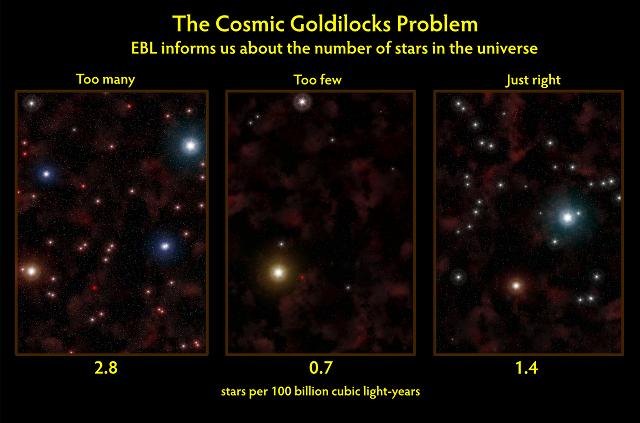
The first stars in the Universe were evidently cosmic hooligans, knocking electrons off atoms, making much of the hydrogen gas in interstellar space ionized. This reionization happened between the formation of the first atoms (about 380,000 years after the Big Bang) and some point roughly a billion years later. However, observations of this era are challenging, so the precise conditions of reionization are not well understood.
Now a study using the Fermi Gamma-ray Space Telescope has used the light emanating from supermassive black holes known as blazars to measure the diffuse light produced by reionization. When high energy gamma rays interacted with the ultraviolet photons produced by early stars, they were converted to particle/antiparticle pairs, and this creates a dropoff at a specific point in the blazar spectrum. This absorption was evident in a sample of 150 blazars, and the data can help constrain models of the very first stars in the Universe.
The first stable atoms formed about 380,000 years after the Big Bang, in an event called recombination. This primarily means that electrons joined with protons to form hydrogen. Subsequently, many of those atoms were broken apart again in an event cosmologists refer to as reionization.
The era of reionization included the period when the first stars and galaxies must have formed. Hot, young stars pump out a lot of ultraviolet (UV) light, which is perfect for ionizing hydrogen and helium gas, so the general consensus is that the earliest stars must have powered reionization. The UV light from these stars is known as the extragalactic background light (EBL). However, the details of this light are hard to come by, since UV light is easily absorbed and scattered by other objects, including the gas in the Milky Way.
This new Fermi study sidesteps that problem entirely, by looking for the indirect evidence of the EBL's presence, rather than trying to detect the UV light itself. A high-energy gamma ray photon passing through the radiation from young stars could interact with a UV photon, producing an electron-positron pair. (This is essentially reversing the process of an electron and positron annihilating each other.) A precise exchange of energy is required for such an event, since the electron and positron have a joint mass that requires the equivalent energy to form (according to Einstein's famous formula E = m c2).
Blazars are excellent sources of high-energy gamma rays. When matter falls onto a supermassive black hole, the result is often a bright jet; a blazar results when that jet happens to point directly at Earth. Since blazars generally have no intrinsic absorption from surrounding gas, the light typically reaches us without interruption.
However, if a gamma ray from a blazar above the energy limit passed through the EBL, it would vanish from the blazar's output. The researchers took a sample of 150 previously identified blazars and correlated their spectra. While data from any single black hole was ambiguous, the large number of black holes under consideration gave them a better statistical power. The analysis showed a clear cutoff: some photons that should have been present were missing, and they corresponded to the amount we'd expect if the EBL was there.

Even better: the position and degree of the dropoff in the blazar spectrum indicated how many stars contributed to the EBL, and how massive those stars were. More massive stars are brighter, hotter, and therefore emit more energetic light. If the early Universe was full of extremely massive stars (as many models suggest), then there would be a stronger cutoff in the gamma ray spectrum. The Fermi results revealed a more moderate outcome: the biggest stars likely formed in the very earliest days of reionization, and their rate of formation was lower than some theories predicted.
These data are extremely significant, as they both confirmed the existence of the EBL for the first time, and provided constraints on models for formation of early stars. With other observations from pending projects such as the Atacama Large Millimeter Array (ALMA), the mysteries of reionization and the first stars may soon be solved.
Science, 2012. DOI: 10.1126/science.1227160 (About DOIs).
reader comments
27